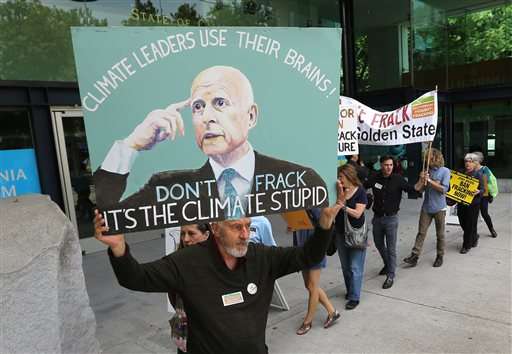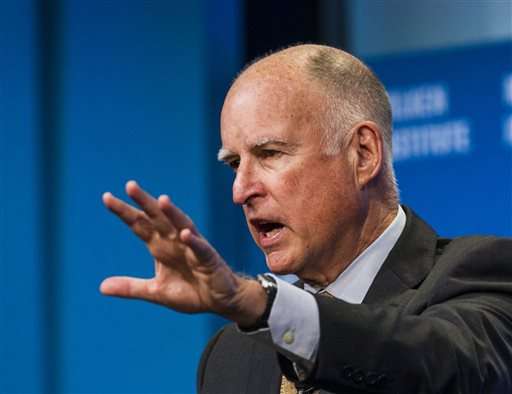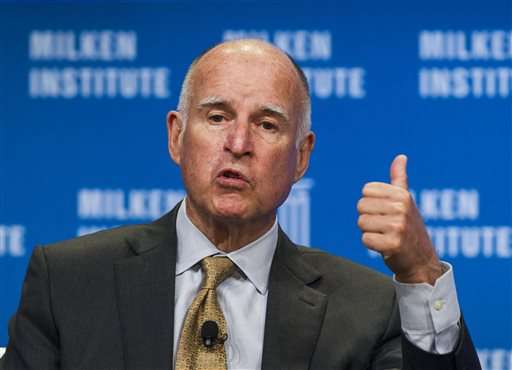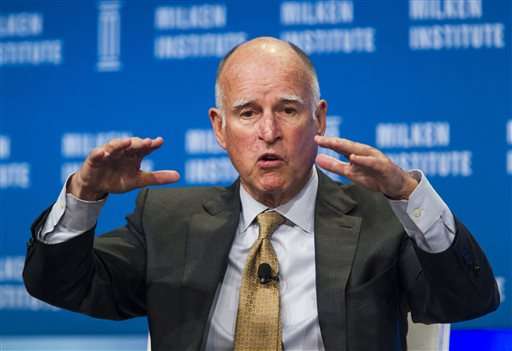California ramps up efforts to cut greenhouse gas emissions

Building on California's ambitious effort to curb greenhouse gas emissions, Gov. Jerry Brown on Wednesday called on the state to further slash its carbon footprint over the next 15 years.
Brown set a new target of reducing emissions to 40 percent below 1990 levels by 2030, calling it the most aggressive benchmark enacted by a government in North America.
The goal is a mile marker on the way to cutting emissions by 80 percent from 1990 levels by 2050 that was set by Brown's predecessor, former Gov. Arnold Schwarzenegger.
"I've set a very high bar, but it's a bar we must meet," Brown said during a climate conference in Los Angeles.
California, which already has an aggressive plan to combat global warming, currently is on track to meet a goal of cutting carbon emissions to 1990 levels by 2020, partly by forcing companies to pay for their pollution.
The state's cap-and-trade program, launched nearly three years ago, offers one of the few real-world laboratories on how to reduce heat-trapping emissions. It expanded this year to fine companies that produce gasoline and other fuels, prompting predictions that consumers will see a spike in prices to cover the costs.
Brown's executive order lacked details on how the state would achieve further emissions reductions—the equivalent of taking 36 million cars off the road, more than all the vehicles registered in California last year.
State officials said it would require accelerated development of renewable energy and alternative fuel sources, and getting more electric cars and zero-emission heavy-duty trucks on the road.
"The good thing is we got a running start right now," said Stanley Young, spokesman for the California Air Resources Board.

Brown's action comes amid aggressive efforts aimed at fighting the state's historic drought, which has been California's primary environmental concern in recent months.
Brown, the first and likely only California governor to serve four terms, has sought to establish his legacy as an environmental leader. At his inauguration earlier this year, he challenged the nation's most populous state to increase renewable energy use to 50 percent in the next 15 years.
The Democratic governor has had to balance his environmental agenda with political and economic reality: The state of nearly 39 million people continues to grow rapidly and needs more housing, freeways, goods and services to accommodate its residents.
While environmental groups generally praised Brown's latest effort to address climate change, he has faced intense pressure from environmentalists and others to ban the practice of hydraulic fracturing, or fracking, for oil.
David Braun, a member of a group called Californians Against Fracking, said the governor's goal was commendable but insufficient.
Brown's interim target aligns California with those of leading international governments ahead of the United Nations Climate Change Conference in Paris later this year. The 28-nation European Union has set the same greenhouse-gas reduction target for 2030.
The executive order is loftier than a federal goal that also aims to curb global warming, but it gives California more time to achieve it. Earlier this year, President Barack Obama announced a plan to cut carbon dioxide emissions 26 percent to 28 percent by 2025, with 2005 levels as the starting point.

The state Legislature is debating various climate change-related bills including proposals to boost renewable electricity, reduce gasoline-powered cars and make buildings more energy efficient.
Democratic Sen. Fran Pavley said she will incorporate Brown's midterm target in her climate change bill, which directs the state to reduce emissions of heat-trapping gases to 80 percent below 1990 levels by 2050.
Discover the latest in science, tech, and space with over 100,000 subscribers who rely on Phys.org for daily insights. Sign up for our free newsletter and get updates on breakthroughs, innovations, and research that matter—daily or weekly.
Business and consumers groups expressed concern about the impact to low-income communities and companies.
"Prior to moving forward with new, aggressive goals, California elected officials must provide the tools that manufacturers and other sectors need to reduce emissions and stay competitive in a global economy," Dorothy Rothrock, president of the California Manufacturers & Technology Association, said in a statement.

Requirements stemming from California's landmark global warming law passed in 2006 have led to higher energy bills for residents and businesses, said Rob Lapsley, president of the California Business Roundtable and a member of Californians for Affordable and Reliable Energy.
Lapsley said he supports Brown's goal but thinks other states must be included.
"We can't afford to be out there by ourselves. That's going to hurt our economy," he said.
© 2015 The Associated Press. All rights reserved.



















